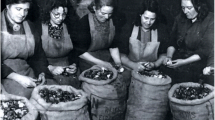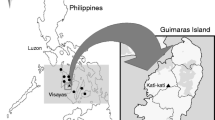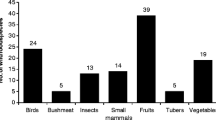Abstract
Based on a representative sample of 449 different individuals, food avoidances are shown to be nutritionally insignificant on average for a population of horticulturalists and foragers living in the Ituri Forest of northeastern Zaire. However, due to variability in food-related beliefs, nutritional costs may be biologically significant for a few individuals. Less than 2% of potential dietary calories are restricted to horticulturalists on average due to food avoidances, while less than 1% is the average cost of these beliefs among foragers. When nutritional costs are calculated from reported avoidance rules rather than consumption practice, estimated costs are significantly inflated. These lower actual costs arise because individuals make use of rules that permit them to eat otherwise restricted foods. For example, eating specific plants is believed to prevent the illness that would otherwise follow the consumption of a tabooed food. Use of such exception rules significantly reduces the nutritional cost of food avoidances for many individuals in this population.
Similar content being viewed by others
References
Aunger, R. (1992).An Ethnography of Variation: Food Avoidances Among Horticulturalists and Foragers in the Ituri Forest, Zaire. Unpublished Doctoral dissertation, UCLA, Los Angeles.
Bailey, R. C., and DeVore, I. (1989). Research on the Efe and Lese populations the Ituri Forest, Zaire.American Journal of Physical Anthropology 78(4): 459–471.
Bailey, R. C., and Peacock, N. R. (1988). Efe Pygmies of northeast Zaire: Subsistence strategies in the Ituri Forest. In de Garine, I., and Harrison, G. A. (eds.),Coping with Uncertainty in Food Supply. Oxford University Press, Oxford, pp. 88–117.
Bailey, R. C., Jenike, M. R., Ellison, P. T., Bentley, G. R., Harrigan, A. M., and Peacock, N. R. (1992). The ecology of birth seasonality among agriculturalists in Central Africa.Journal of Biosocial Science 24: 393–412.
Dietz, W. H., Marino, B., Peacock, N. R., and Bailey, R. C. (1989). Nutritional status of Efe pygmies and Lese horticulturalists.American Journal of Physical Anthropology 78(4): 509–518.
Douglas, M. (1966).Purity and Danger: An Analysis of Concepts of Pollution and Taboo. Routledge and Kegan Paul, London.
Ferro-Luzzi, G. E. (1980a). Food avoidances at puberty and menstruation in Tamiland. In Robson, J. (ed.),Food, Ecology and Culture: Readings in the Anthropology of Dietary Practices. Gordon and Breach, New York, pp. 93–100.
Ferro-Luzzi, G. E. (1980b). Food avoidances in pregnant women in Tamiland. In Robson, J. (ed.),Food, Ecology and Culture: Readings in the Anthropology of Dietary Practices. Gordon and Breach, New York, pp. 101–108.
Ferro-Luzzi, G. E. (1980c). Food avoidances during the puerperium and lactation in Tamiland. In Robson, J. (ed.),Food, Ecology and Culture: Readings in the Anthropology of Dietary Practices. Gordon and Breach, New York, pp. 109–117.
Frazer, J. G. (1911).The Golden Bough: A Study in Magic and Religion (3rd Ed.). MacMillan, London.
Gerlach, L. P. (1961). Economy and protein malnutrition among Digo.Minnesota Academy of Science Proceedings 29: 3–13.
Grinker, R. R. (1990).Ambivalent Exchanges: The Lese Farmers of Central Africa and Their Efe Pygmy Trading Partners. Unpublished Doctoral dissertation, Harvard, Cambridge.
Harris, M. (1979).Cultural Materialism: The Struggle for a Science of Culture. Random House, New York.
Harris, M. (1987). Foodways: Historical overview and theoretical prolegomenon. In Harris, M., and Ross, E. B. (eds.),Food and Evolution: Toward a Theory of Human Foodways. Temple University Press, Philadelphia, pp. 57–92.
Hart, J. A. (1978). From subsistence to market: A case study of the Mbuti net hunters.Human Ecology 6(3): 324–353.
Hill, K. (1982). Hunting and human evolution.Journal of Human Evolution 11: 521–544.
Hull, V. J. (1986). Dietary taboos in Java: Myths, mysteries, and methodology. In Manderson, L. (ed.),Shared Wealth and Symbol: Food, Culture, and Society in Oceania and Southeast Asia. Cambridge University Press, Cambridge, pp. 237–258.
Koppert, G., and Hladik, C. M. (1990). Measuring food consumption. In Hladik, C. M., Bahuchet, S., and de Garine, I. (eds.),Food and Nutrition in the African Rain Forest. UNESCO/MAB, Paris, pp. 59–61.
Laderman, C. (1983).Wives and Midwives: Childbirth and Nutrition in Rural Malaysia. University of California Press, Berkeley, CA.
Leung, W. W. (1968).Food Composition Table for Use in Africa. Food and Agricultural Organization of the United Nations/United States Department of Health, Rome.
Levi-Strauss, C. (1966). The culinary triangle.Partisan Review 33: 586–595.
Ogbeide, O. (1974). Nutritional hazards of food taboos and preferences in midwest Nigeria.American Journal of Clinical Nutrition 27: 213–216.
O'Laughlin, B. (1974). Mediation of contradiction: Why Mbum women do not eat chicken. In Rosaldo, M. Z., and Lamphere, L. (eds.),Women, Culture and Society. Stanford University Press, Stanford, pp. 301–318.
Pagezy, H. (1990). Feeding the primiparous mother among the Ntomba of Zaire. In Hladik, C. M., Bahuchet, S., and de Garine, I. (eds.),Food and Nutrition in the African Rain Forest. UNESCO/MAB, Paris, pp. 89–91.
Rosenberg, E. M. (1980). Demographic effects of sex-differential nutrition. In Jerome, N. W., Kandel, R. F., and Pelto, G. H. (eds.),Nutritional Anthropology: Contemporary Approaches to Diet and Culture. Redgrave, Pleasantville, NY, pp. 181–203.
Schebesta, P. (1936).My Pygmy and Negro Hosts. Hutchinson and Co., London.
Schebesta, P. (1937).Revisiting My Pygmy Hosts. Hutchinson and Co., London.
Speth, J. (1990). Seasonality, resource stress, and food sharing in so-called “egalitarian” foraging societies.Journal of Anthropological Archaeology 9: 148–188.
Spielmann, K. A. (1989). A review: Dietary restrictions of hunter-gatherer women and the implications for fertility and infant mortality.Human Ecology 17(3): 321–345.
Tambiah, S. J. (1969). Animals are good to think and good to prohibit.Ethnology 8: 423–459.
Trant, H. (1954). Food taboos in East Africa.Lancet 2: 703–705.
Turnbull, C. M. (1965). The Mbuti Pygmies: An ethnographic survey.Anthropological Papers of the American Museum of Natural History 50(3): 139–282.
Vansina, J. (1990).Paths in the Rainforests: Toward a History of Political Tradition in Equatorial Africa. University of Wisconsin Press, Madison.
Wilkie, D. S. (1989). Impact of roadside agriculture on subsistence hunting in the Ituri Forest of northeastern Zaire.American Journal of Physical Anthropology 78(4): 485–494.
Wilson, C. S. (1980). Food taboos of childbirth: The Malay example. In Robson, J. (ed.),Food, Ecology and Culture: Readings in the Anthropology of Dietary Practices. Gordon and Breach, New York, pp. 67–74.
Wilson, C. S. (1987). Review of M. Harris'sGood to Eat.Ecology of Food and Nutrition 19: 351–353.
Author information
Authors and Affiliations
Rights and permissions
About this article
Cite this article
Aunger, R. The nutritional consequences of rejecting food in the Ituri Forest of Zaire. Hum Ecol 20, 263–291 (1992). https://doi.org/10.1007/BF00889898
Issue Date:
DOI: https://doi.org/10.1007/BF00889898




